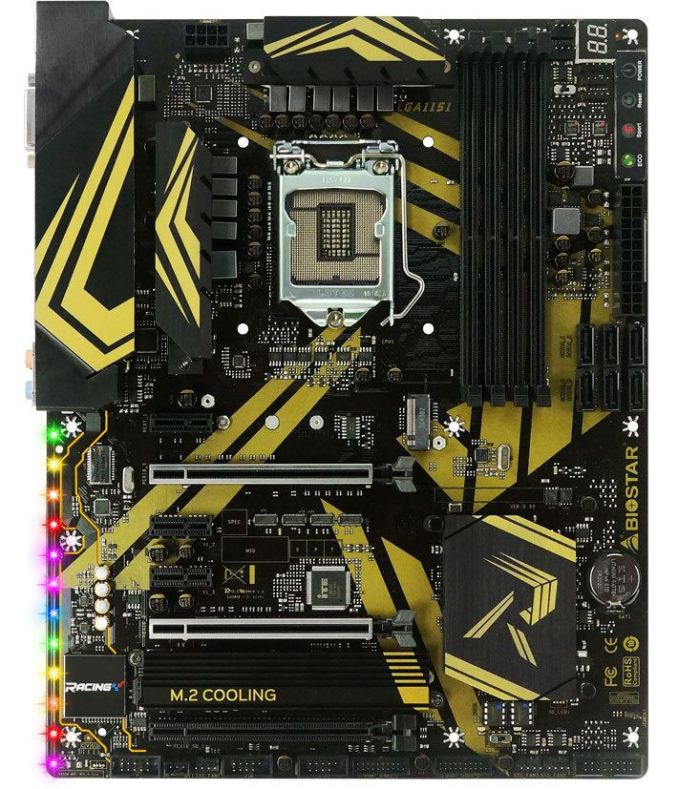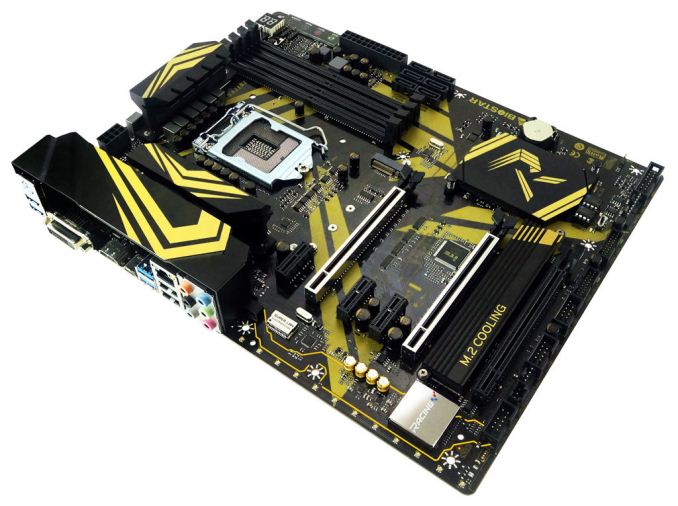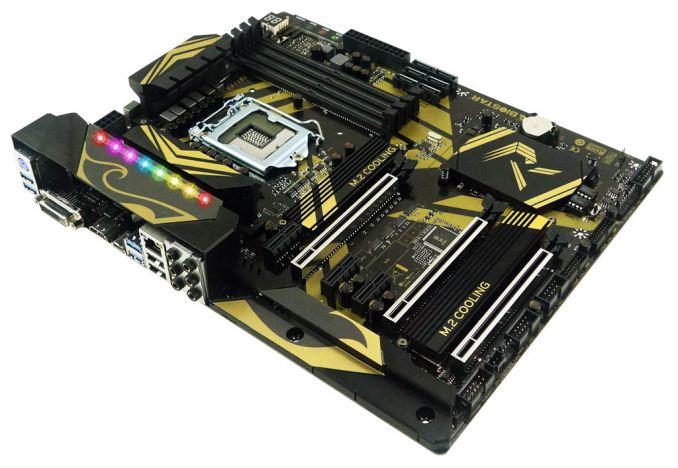Analyzing Z370 for Intel's 8th Generation Coffee Lake: A Quick Look at 50+ Motherboards
by Ian Cutress, Anton Shilov, Joe Shields & Gavin Bonshor on October 20, 2017 2:00 PM ESTNot willing to be left behind at the starting line, Biostar has announced its entries into the rapidly growing Z370 motherboard market. At the time of publication, Biostar is bringing two boards to the table from their Racing line with the Z370GT7 and Z370GT6. The GT7 is the company's flagship board and, accordingly, will be the more expensive of the two. While both are full-featured motherboards, the GT7 offers an additional M.2 heatsink over the GT6, an additional PCIe slot reinforced over the GT6, as well as additional shrouding covering the audio section of the board. Outside of that, differences between the boards will be difficult to spot.
BIOSTAR Racing Z370GT7 and Z370GT6
The Biostar Racing line is in its third generation aesthetic, which features a gold and black color theme. All the heatsinks on the board are black, and adorned with yellow accent,s while the PCB itself is black. The “R” (Racing) symbol is found prominently on the chipset heatsink. Other gold accents are found scattered around the board.
Both boards also feature three full-length PCIe x16 slots and three x1 slots. In the top right corner, both boards have a debug LED, BIOS switch, and a panel with four buttons on it for power/reset functionality, as well as Turbo and Eco mode buttons. RGB LEDs can be found on both boards with the GT7’s located on the back panel IO shroud, while the GT6’s are found on to the left of the audio section. The integrated LEDs and external LEDs (via two headers) can be controlled with Biostar’s Vivid LED DJ utility. It features 10 different flashing modes along with color, speed, and brightness controls allowing control over each lighting zone independently.
Neither board uses reinforced memory slots, however there are two full-length PCIe slots with reinforcement on the GT6 and all three slots on the GT7 get reinforced. The slots break down to x8/x8 on the top two slots from the CPU, with the third slot being PCIe 3.0 x4 from the chipset. This means both boards support 3-way AMD Crossfire, although Biostar hasn't gone through the SLI process to get SLI certification. That last full-length slot at x4 shares bandwidth with the second M.2 slot. The boards four memory slots support up to 64GB, with speeds supported to DDR4-3866.
For mass storage purposes, both boards use the full allotment of six chipset managed SATA ports. However instead of locating these in their typical position to the right of the PCH heatsink on the bottom half of the board, Biostar as placed them towards the middle of the board oriented them vertically, which leads to issues when one cable needs to be removed - the one or two cables above it have to be disconnected first. For M.2, the first slot is above the top full-length PCIe slot and supports up to 80mm drives, while the second slot can be found between the bottom two PCIe slots and supports up to 110mm devices. The GT7 offers heatsinks on both M.2 slots, while the GT6 only one on the bottom slot.
As for cooling, the board gives users a total of five four-pin fan headers to use, only two of which are in the socket area. These can be controlled via voltage or PWM through the BIOS or through the Windows-based application. Audio functionality is handled by the Realtek ALC1220 codec, uses EMI shielding, what looks to be Chemicon audio caps, as well as separation from the rest of the board. Network capabilities on both boards and handled by the Intel I219-V Gigabit Ethernet which supports LAN surge protection.
Both the GT6 and GT7 have the same number and types of USB ports. There are two USB 3.1 (5 Gbps) Type-A ports and one Type-C on the back panel, and an additional two USB 2.0 ports. Internally there is an additional USB 3.1 (5 Gbps) header and USB 2.0 header for front panel connections. The back panel IO also contains a keyboard PS/2 port, DVI-D, and HDMI for video outputs, as well as a six-jack audio stack. The GT7 chooses to use all black colored plugs versus the GT6 using the color-coded version most are familiar with.
| Biostar Z370GT6 & Z370GT7 | |
| Warranty Period | 3 Years |
| Product Page | Z370GT6 / Z370GT7 |
| Price | N/A |
| Size | ATX |
| CPU Interface | LGA1151 |
| Chipset | Intel Z370 Express |
| Memory Slots (DDR4) | Four DDR4 Supporting 64GB Dual Channel Support DDR4 3866(OC) |
| Network Connectivity | 1 x Intel I219-V LAN |
| Onboard Audio | Realtek ALC1220 |
| PCIe Slots for Graphics (from CPU) | 2 x PCIe 3.0 x16 slots @ x16 or x8/x8 |
| PCIe Slots for Other (from Chipset) | 1 x PCIe 3.0 x16 slots @ x4 3 x PCIe 3.0 x1 slots @ x1 |
| Onboard SATA | 6 x Supporting RAID 0/1/5/10 |
| Onboard SATA Express | None |
| Onboard M.2 | 2 x PCIe 3.0 x4 - NVMe or SATA |
| Onboard U.2 | None |
| USB 3.1 (10 Gbps) | 2 x Type-A (10 Gbps) Back Panel 1 x Type-C (10 Gbps) Back Panel |
| USB 3.0 (5 Gbps) | 2 x Back Panel 1 x Header |
| USB 2.0 | 2 x Back Panel 1 x Header |
| Power Connectors | 1 x 24-pin EATX 1 x 8-pin ATX 12V |
| Fan Headers | 2 x CPU 3 x System (PWM and DC Controlled) |
| IO Panel | 1 x PS.2 keyboard/mouse port 2 x USB 3.1 G2 ports 1 x USB 3.1 Type-C 2 x USB 3.1 Type-A 1 x HDMI 1 x DVI-D 2 x RJ-45 LAN Port 5 x Audio Jacks |
















83 Comments
View All Comments
carldon - Saturday, October 21, 2017 - link
Excellent summary and table in the last page. Good work!!!imaheadcase - Saturday, October 21, 2017 - link
I got a few questions:1. Why do they put USB 2.0 ports if USB 3.0 is backward compatible anyways? Why not just all USB 3.0 ports..it can't be price.
2. Why do they have such a vary in memory timings? For %99 of people memory timings are not really a big deal right? Maybe in old PC days it was.
3. Mini-ITX vs Micro-ITX..isn't it silly both exist in first place? Any reason for this..the diminsions are really close to the same. In fact, most Micro-ITX is simply removing lots of stuff from mobo that you really want to begin with.
lordsutch - Saturday, October 21, 2017 - link
I'd imagine they want to offer as many ports as they can without taking away too many PCIe lanes. The other option would be to embed a USB 3.x switch (or a PCIe switch) but of course now each port wouldn't simultaneously be able to operate at peak speed and 3.x switches are probably more expensive than USB 2 controllers.imaheadcase - Sunday, October 22, 2017 - link
Ahh didn't think about that aspect.DanNeely - Saturday, October 21, 2017 - link
Some USB audio and 2.4ghz wifi/bluetooth devices have had interference problems in 3.0 sockets. Dunno if they're fixed on new hardware (supposedly onboard hubs were a lot worse than chipset ports in this regard so room for QC to make it better); but even if they are there's going to be problems with once burned customers not trusting them.As pointed out elsewhere USB3 competes with PCIe lanes/SATA ports on the southbridge. Especially on full ATX boards if you go to max out the number of PCIe lanes to expansion slots and m.2 ports in addition to the lanes used on board for networking and audio you can get down to only a half dozen or so 3.0 lanes left from the chipset; but still able to hit 14 USB ports total by going USB2 with the rest.
People using older OSes (Windows 7 says hi) can't use USB3 ports to install the OS without jumping through a lot of hoops (the OS sees them as not USB2 and can't talk to them).
If any board size is at risk of going away it's probably full ATX; although for enthusiast sales I suspect it'll hold on better than mini ATX due to bigger is better irrationality.
MiniITX still has a decent capability gap vs mini ATX; but it's much smaller than it was a half dozen years ago when it only made sense if you were making a tiny box and were willing to accept major performance compromises to do so. Now as Mini ITX's capability continues to goes up and the need for expansion cards other than a single GPU goes down it's eating into an increasing chunk of Mini ATX's marketshare.
On the high side mainstream chips don't really have enough PCIe lanes to make good use of the extra 3 cards of space possible on the bigger boards/ Meanwhile multi-GPU gaming - the main reason an enthusiast would need a full size mobo is steadily going away (fewer games supporting it each year, no support for 3/4way at all in the newest cards from either company); and unless you need 2 GPUs + something else or extra space around the CPU for crazy OCing Mini ATX does almost everything that could be needed.
MadAd - Sunday, October 22, 2017 - link
> If any board size is at risk of going away it's probably full ATX; although for enthusiast sales I suspect it'll hold on better than mini ATX due to bigger is better irrationality.Irrationality indeed. I would have thought by now instead of a measly 5 mATX choices out of 50+ that it would be instead maybe 5 fullsize ATX with the main battleground being the two slot mATX market.
Its just laziness on the manufacturers side, with nobody steering the market to innovate on size. Theres nobody driving form factors, the CPU companies are present on all form factors so they dont need to drive change, the board partners are all set in their ways just slapping new images on mildly reworked designs so they dont have any need to innovate, weve seen video card manufacturers can shrink designs to better fit smaller factors but we still get chunky easy to produce cards for mainstream use as retooling would be an added cost, its just rolling train of new but nothing new generation after generation.
PC design is falling into mediocrity and I just wish the main players (intel+amd/board partners/nvidia+amd) would all get together to drive SFX/ITX and force retire ATX to the strictly enthusiast market, and maybe appeal to a more contemporary home user community (rather than just gamers which is where the marketing all seems to be these days) again too.
Liltorp - Saturday, October 21, 2017 - link
It is really true that the MSI PC Pro has a legacy PCI connector? I could use this for my TV tuner. But I thought PCI was not supported by newer boatds/CPU`s?Morawka - Saturday, October 21, 2017 - link
Has anyone noticed how cheap these new Z370 motherboards are? Most are under $180 and there are several sub $130.IGTrading - Sunday, October 22, 2017 - link
Tell this to the guys that already spent money on non-Z370 just a few months ago.Intel is already screwing them.
It would have been funny to sell a 250 USD motherboard to a 7700K buyer just last month, telling him his 250 USD are a good investment because of the good upgradeability.
Just 4 weeks later tell him: "Well ... Yeah ... About that upgrade ... It will cost you a minimum of 110 USD extra + the 360 USD for the new 8700 K.
775 was the last good & long lived platform from Intel.
edzieba - Sunday, October 22, 2017 - link
If people brought Z370 boards expecting them to support an additional CPU generation, they did it in spite of every Intel CPU release for the last decade: two CPU gens socket generation. There's no counter to ignoring the past.